#Fertilizer Production Line Systems
Explore tagged Tumblr posts
Text
Demonizing menstruation doesn't help spread information, mysticizing menstruation doesn't help spread information. Going completely neutral is the only way forward.
Periods are an expulsion of waste. They're no more gross than pissing is. The social etiquette of "excuse me I have to go to the bathroom" shouldn't change because someone puts a pad in their pocket before they head off.
Period blood is blood, along with endometrial cells. It isn't more dangerous or gross than the blood that comes out of a wound. It should be treated with the same level of caution because of the potential for disease transmission, but it's not some toxic sludge that you're going to die from looking at wrong. If blood gets on a nonporous surface a simple antibacterial wipe will remove it and prevent the spread of most potential diseases. For a porous surface like fabric soap and water may be enough, or hydrogen peroxide if the stain is stubborn. More careful steps may need to be taken if the blood may or does contain HIV, but it's important to remember that HIV can only be contracted by blood-to-blood contact or sex. Blood from a person with HIV isn't that much more dangerous than regular blood, just try not to touch blood directly in general and wash your hands correctly after handling soiled objects and you'll be fine.
Periods are not your body "punishing you" for not being pregnant. Your body is just a container for you, it doesn't have any feelings that you don't have. If you don't want kids but feel guilty about not having them, it is not your uterus making you feel guilt. That's you being reminded by your period to feel guilt because you were conditioned growing up to view everyone with a uterus as valuable only in terms of their ability and desire to carry children. Anthropomorphizing the function of your reproductive system is the way you deal with the guilt of not living up to your societal "purpose" of bearing children. Everyone who doesn't have kids, has kids late, or has a journey regarding children that's different from the societal norm deals with that to a certain extent, although people who were raised as girls/women tend to deal with it more. It's a line of thinking that you will likely need to work through, either alone or with a sympathetic therapist, in order to be content. Also, if your periods feel like a punishment that could be a sign that something is wrong.
Periods aren't supposed to disable you. Cramping should be at a "oops I ate something that didn't quite settle with me" level not a "cosplaying as a wounded animal" level. You should be able to pop your over-the-counter pain medication of choice and not have to think about the fact that you're on your period aside from the occasional bathroom trip to change your menstrual product. Bleeding through pads or tampons on an hourly basis isn't normal. Fainting from blood loss or pain isn't normal. Being unable to complete daily tasks, or completing them with difficulty, due to pain is not normal. Nausea or vomiting that interferes with your ability to stay fed and hydrated isn't normal.
Irregular periods can be normal, some people just don't get periods on a consistent schedule. Going more than 35 days between can be a sign that something is wrong. Going more than 90 days without a period, sometimes called "losing" your period, can be a sign that something is wrong. If you don't want to have a period, forcing yourself to "lose" it through starvation, overexercise, or stress is not a safe way to do it. These behaviors can have other long-term consequences, including premature death. Hormonal birth control can be taken consistently, skipping periods, with no excess effect on fertility or personal health that we're aware of.
Emotionality is normal before and during your period. Crying at a cat video that you would normally scroll past without thinking is normal. It's ok to be frustrated with emotionality, it can be annoying to feel out of control. It's also ok to withdrawal from others for a short time when you feel unable to socialize. Panic attacks, depression, sleep disturbances, loss of interest, and other major mood disturbances are not normal and can be a sign of premenstrual dysphoric disorder (PMDD). PMDD is as serious as other depressive disorders and can lead to suicide.
Your reproductive system isn't self-contained, it's connected to the rest of your body via blood supply and other mechanisms. Even if you plan to have a hysterectomy or other permanent birth control at some point it's still important to get "period problems" checked out to ensure the rest of your body isn't affected.
People deal with their periods how they deal with them and it's none of anyone's business. Someone isn't lazy for not feeling up to activities during their period. People who eat junk food on their period aren't "making themselves feel worse". Judging someone's choice in menstrual products is so fucking weird and rude, yes I am judging you back. People who skip their periods using birth control (hi!) aren't ruining their bodies with chemicals. People who choose not to use birth control or don't use it for that purpose aren't choosing to suffer for no reason. People are infinitely complex in the ways they choose to deal with inconvenience and challenge and tearing each other down for not being the same is unproductive. Period stigma can only end when we work together, trans and cis, intersex and dyadic, all gender presentations, races, sizes, and abilities, to make it work.
In the theme of the last paragraph, if anything in this post is incorrect or uninclusive, please let me know and I'll fix it asap.

[image ID: a banner that reads "TERFs and SWERFs DNI].
#periods#menstruation#feminism#inclusive feminism#intersectional feminism#the menstruation masterpost
63 notes
·
View notes
Text
Remember you asked for this. Here's the fairy sex ed post
Partially cross posting from twitter but without nearly as much of a character limit, if you recognize it no you don't <3
Vaguely nsft under the cut; this is intended to be a psuedoscientific exploration of speculative biology and fairy reproduction, please don't reply to this post with highly sexual commentary (jokes are fine lmao) because this is primarily a family friendly blog.
Prefix:
Starting this off by saying that, while this post is going to focus on reproduction via their physical forms, fairies are essentially made of magic and can, for the most part, manipulate those forms at will. Think of these like the default settings of physical manifestation. Also it's worth noting that while I'm for the most part using human biology terms, fairies themselves probably have ridiculously whimsical names for all these organs that have existed for billions of years, but this isn't a language post. This is not meant to be a full comprehensive medical guide to the complexities of gender in fairy culture, nor will it cover every possible variation of default physical forms. This is your middle school "where do babies come from" level of documentation. The terms "male" and "female" are used to describe fairies as they are "assigned" at birth, however, please don't take this to mean trans and nonbinary fairies don't exist, they definitely do.
Anatomy:
When manifesting physical forms, fairies develop traits based on the dominant species of the world they will primarily engage with, in this case, humans. (1) This leads to the development of secondary sex characteristics such as breast tissue and facial hair. While these traits have evolved over millennia spent alongside humans, they are still derived from magic, and can not be used to qualify fairies as mammals. Fairies are an oviviparous species, meaning an embryo will develop within a fertilized egg and depend on that egg for nutrients, but will hatch inside the parent's body and result in a live birth. (2)

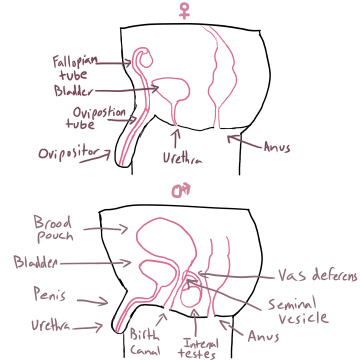
Females produce eggs and lay them via an ovipositor. Males produce sperm via internal testes used to fertilize eggs as they pass through the birth canal towards the brood pouch via penetration by ovipositor. The birth canal and ovipositor are both is self lubricating when aroused to assist the transfer of eggs, and the internal pelvic muscular structure in male fairies is designed to pull the eggs as deep as possible to increase chances of fertilization within the brood pouch. The urinary and reproductive systems are completely separate because they keep canonically arguing about leaving the toilet seat up and while I'm only loosely respectful of canon I can also do whatever I want forever. The female urethra exists behind the ovipositor while the male urethra is connected to a non-reproductively functional penis. Ovipositors tend to be slightly larger than penises, and female fairies tend to be slightly larger than males in general, but this is primarily dependent on the individuals Both the ovipositor and penis have an abundance of nerve endings and experience arousal, though male ejaculation is entirely internal. The brood pouch is functionally a uterus in human terms, however, as the developing embryo derives nutrients from the egg and has no need to fully attach, the brood pouch does not have a lining and, sorry everyone, men don't get periods, nobody has to get periods in my world because I'm a benevolent god. Fairies experience 3 types of puberty, "pooferty(3)" "pasta puberty(4)" and sexual maturation. The first two of these involve developmental milestones and magic-hormone interactions, so they are best set to the wayside for a different post, though I will note here that most secondary sex characteristics will develop in manifest forms at the end stages of pasta puberty. The sexual maturation stage of puberty is the only stage in which hormone production is more of an active cause than magic. Females may begin laying eggs during this time, and nocturnal depositing is very common in teenagers and nothing to be ashamed of, it's a very normal experience to wake up to the occasional egg or two. At the end of class you'll receive a pamphlet with a section on proper disposal spells. Males may experience abdominal cramping during third puberty, as their brood pouch swells slightly to accommodate possible eggs, this is not cyclical in the way human periods are, and once they've had their last growth spurt and the pouch settles in its more spacious form, any residual cramping should subside. Until then, the pamphlets offered at the end of class will also have a section on magical pain relief.
Reproduction:
A female fairy can lay between 1-5 eggs, which are semi-gelatinous in texture and range from .5"-1" (1.27-2.54cm) in size. Egg coloration comes in a myriad of pastels, but despite some outdated theories, the coloration of the egg indicates nothing about the potential appearance of the baby. As previously stated, when the female lays her egg/s inside the male they are fertilized internally. The male will carry the fertilized egg/s in his brood pouch, but the embryo will remain inside the egg through development, using it as a source of magical nutrients If an egg laid inside a partner in whatever orifice is not successfully fertilized, it dissolves within a matter of 6-12 hours. Birth control looks a lot different for fairies because it's essentially exclusive to a morning after spell to forcibly dissolve the eggs anyway. After a 3 month gestation period, the embryo will have fully absorbed the nutrients from the egg and will essentially have "eaten" it's way out, which will trigger the father going into labor and, theoretically, delivering the baby via birth canal. In practice however, magical c-sections(5) were the go-to long before the baby ban. Seriously this has been the preferred method for millennia. Only holier-than-tho crunchy granola weirdos get superior about non-magically assisted delivery.
Citations:
In s3ep12 Abracatastrophy we learn that fairies take on godparenting duties and physical traits of the earths dominant species.
https://byjus.com/biology/viviparous-oviparous-embryo-development/#ovoviviparity
s9ep38 School of Crock Peri goes through pooferty, but this is also one of those concepts I've entirely restructured in my mind.
ANW s1ep18 Growing Pains introduces pasta puberty, and I'm keeping that canon on the grounds that it's funny.
In s6ep1 Fairly Odd Baby we gain a basic and superficial overview of fairy gestation. It's the mpreg episode.
#fairly oddparents#fopanw#fop#fairly oddparents a new wish#bioposting#wordspill#ns/ft#kind of but like this is pg11 lol
16 notes
·
View notes
Text
As we age, it is almost as if we suffer a curse; every single thing in our body seems to work less well over time, and once we hit old age, it all seems to start breaking down rather quickly. Everything from how well we heal from injuries, to our immune system, to our senses seems to start falling apart at once.
As I understand it, the evolution of aging is the result of an almost accidental trade-off between reproductive fitness in the short term, and consequences for the individual member of the species in the long term. For instance, you have animals like octopuses and salmon who mate once then die, usually producing many hundreds of offspring. This is because lots of small cumulative adaptations that helped reproduction in the short term had negative consequences for the individual in the long term--but because these animals got so good at making that first reproductive opportunity really successful, the cost for fewer future opportunities to reproduce was (in terms of reproductive fitness) small. And over time their ancestors leaned harder and harder into this strategy.
Humans obviously aren't anywhere near that specialized. Our offspring are normally one at a time (and multiples are very high risk) and require a lot of care. Like all mammals, we nurse and look after our young. But there's still a degree of evolutionary tradeoff; base rates of disease and accident still make betting on reproductive opportunities too far in the future a losing proposition, and the act of giving birth is itself very dangerous for women, so it makes sense to still somewhat front-load our reproductive opportunities, and if we survive for a long time, to transition to a more supportive role for other members of the community (as indeed some hypothesize is the reason menopause evolved in the first place; but note male fertility also declines with age, even though there's no exact male equivalent to menopause).
So deleterious mutations that affect us mostly in our old age, or adaptations that come with a benefit in the short term, and with a high cost in the long term, probably built up in our genome for the same reasons that they did in that of octopuses and salmon, just in a less dramatic way. And so it makes sense that when we age, lots of things tend to go wrong. Aging isn't the product of a single process of system; it's the product of many systems in our bodies breaking down, because they have a degree of planned obsolescence built into them. This is why we shouldn't expect anti-aging interventions to be big dramatic breakthroughs that suddenly fix everything. We have lots of problems to deal with when it comes to "curing" aging, from shortening telomeres and waste products building up in our cells to UV damage to the eyes and loss of bone density, all from different sources.
Despite the image we may have absorbed from science fiction, longevity doesn't look like a single treatment that could easily be monopolized and sold at $100,000 a dose. It looks like hundreds of little things, many of which we're already working on quite diligently and making small-but-important breakthroughs in, and in areas where advances often go from "experimental and possibly very expensive" to "routinely available" in a couple of decades. And this makes sense too! Public health authorities and insurance companies have a vested interest in these advances--a treatment that improves the survival rate for a kind of cancer or helps to prevent heart disease means they have to pay less in more drastic, more expensive medical treatments down the line.
41 notes
·
View notes
Text
Finding the Right Indian Basmati Rice Supplier for Your Business in 2024

In 2024, the global rice market will continue to boom, with Indian basmati rice emerging as one of the most sought-after varieties. Known for its unmatched aroma, long grain, and excellent cooking quality, basmati rice is a staple in cuisines around the world. For businesses looking to enter this lucrative market or strengthen their supply chain, finding the right supplier is a must. This guide helps you navigate the process, ensuring a reliable partnership that aligns with your goals and enhances your product offerings.
Why Indian Basmati Rice Is Different
Indian basmati rice is synonymous with quality and tradition. Grown in the fertile regions of Punjab, Haryana, and Uttar Pradesh, this rice has earned Geographical Indication (GI) status, highlighting its authenticity and origin.
What makes Basmati rice unique is its aging process, where the grains are matured for several months to enhance their flavor and texture. This has led to an increase in global demand despite fluctuations in rice prices. According to the All India Rice Exporters Association, Indian Basmati will account for more than 70% of the global premium rice trade in 2023, thanks to its unmatched reputation.
Key factors to consider when choosing a supplier
When selecting a Basmati rice supplier, several aspects should be considered to ensure a smooth and profitable collaboration:
Certification and quality standards: Look for suppliers with certifications such as ISO, HACCP and BRCGS, which ensure adherence to global food safety and quality standards.
Market reputation: A supplier’s track record in exporting high-quality rice to global markets reflects their reliability and expertise.
Pricing and transparency: Understand the supplier’s pricing model and ensure clarity on factors that impact rice prices, such as logistics, currency exchange, and market demand.
Capacity and timely delivery: Evaluate if the supplier can meet your volume requirements without compromising on delivery timelines.
Top qualities of a reliable Basmati rice exporter
A reliable Basmati rice supplier has these key qualities:
Authenticity assurance: They source rice from GI-tagged regions, which guarantees a genuine Indian Basmati experience.
Sustainability practices: Many buyers today prefer eco-friendly suppliers who follow sustainable farming and packaging methods.
Client-centric approach: Reliable suppliers prioritize building long-term partnerships by offering customization, competitive pricing, and responsive communication.
Global export experience: Suppliers with a strong network and familiarity with international trade regulations make the export process seamless.
Questions to ask potential suppliers
To make an informed decision, ask potential suppliers the following questions:
Where is your rice sourced and processed?
Make sure the supplier has direct links to GI-certified regions and state-of-the-art processing facilities.
Are there quality checks in place?
Discuss their grading system, inspections, and certifications to confirm product consistency.
How do you manage fluctuations in rice prices?
An active supplier can provide information on market trends and hedging strategies to minimize cost variations.
Can you handle custom packaging or branding?
For businesses looking to add unique value to their product lines, suppliers that offer customization are invaluable.
What is your logistics strategy?
Check if the supplier has efficient shipping methods and partnerships with reliable freight companies to avoid delays.
Choosing the Best Option for Your Business
Finding the right Indian rice supplier is a crucial decision that can significantly impact the success of your business in 2024 and beyond. By focusing on authenticity, quality assurance, and supplier transparency, you can build a partnership that aligns with your goals. With global demand for Indian basmati steadily increasing, now is the right time to invest in securing a reliable supplier.
The key to succeeding in the competitive rice market lies in doing your homework, asking the right questions, and prioritizing long-term value over short-term profit.
2 notes
·
View notes
Text
In The Works
Temperature Sensitive Plants Status: needs updating for 1.5, plus still hunting some pernicious bugs
Plants can die of heat. Different plants have different preferred growing temperatures. Many temperate-and-colder plants will die off overwinter and regrow in spring. Not all crops are suited to all biomes.
---
Fired Pottery Status: needs updating for 1.5, needs graphics for kilns
Merges various clay- and pottery-based mods under a single system for sculpting and firing clay, based on Processor Framework. Designed for smooth, comprehensive compatibility across a variety of mods.
---
Expanded Woodworking patches Status: needs updating for 1.5
A couple of extra woods, plus patches for a whole load of wooden things to use woody stuff. Probably going to hand the patches to Expanded Woodworking itself, but may end up publishing an add-on for anything they don't feel like they want in the main mod.
---
Dry Leaves patches Status: needs updating for 1.5
Compatibility patch for Dry Leaves, Vanilla Brewing Expanded, and Jecs Tobacco (which is required for Dry Leaves). Combines the two tobaccos into one and adds a recipe for drying tea leaves.
---
Soft Warm Beds patches Status: needs updating for 1.5
A few tweaks, mostly compatibility patching for a number of neolithic beds, condensing them into a coherent progression/range of options.
---
Textile rebalance Status: needs updating for 1.5
I use quite a lot of mods that add new textiles and leather, and I've written a bunch of patches to bring their balance into line with each other
---
Overcomplicated leather Status: needs updating for 1.5
Consolidates leather into a handful of categories (light, medium, heavy, fur, soft fur, light scale, heavy scale). Production chain based on tanning. Rawhide clothing for tribals. Wool can be cut from the skins of woolly animals, providing they had any when killed.
---
Earthworks frankenpatch Status: needs updating for 1.5
Consolidation of a bunch of mods regarding earth, soil, rock, etc, with the aim of providing a unified system that works with all of them. Primary mods include Expanded Materials Stones and Mortars, Fertile Fields, Primitive Core/Primitive Workbenches.
4 notes
·
View notes
Text

Absolutely none of that made sense, so lets get to it:
We tell you so you don't think we hate you all of a sudden. We get pissed both because of hormone and emotional changes and because of the pain we are in.
Speaking of this pain, women experience cramps more painful than heart attacks. Many women, including myself, experience, muscle and joint pain, back pain, headaches and migraines.
My entire job is not to be "aesthetically pleasing and add femininity." My job is to breathe, eat, hydrate, and sleep. My job is to stay alive. Everything else I do, like go to school, is so that I can continue to live, as our society has made it so education and a paying job are required to be alive. I am a human being who evolved from something whose only concern was eating, drinking, and not dying. I am not an inanimate object just meant to decorate your damn house.
I am not meant to be sexy. Women can start menstruating as early as 8-12. That would mean you are telling children that they are failing at being sexy because they menstruate. Adult men are not supposed to find children who happen to have a vagina sexy. Not to mention the fact that no woman is 'meant' to constantly be sexy, just like men aren't.
The idea that whether your ancestors were hunters or gatherers determines whether you are AFAB or AMAB is absolutely ridiculous. That is not why you get the sex you were assigned at birth. A person's sex is determined by which chromosome, X or Y, the father's sperm has. The egg contributes an X chromosome. Generally, if the sperm has an X chromosome, the egg has an XX chromosome and is a girl. If it has a Y chromosome, it becomes XY, which makes a boy.(1) However, let's give this logic a chance. Say it is true(it is not). If your sex was determined by if your maternal ancestors were hunters or gatherers? A woman would have to have gatherer ancestors, correct? If it is entirely dependent on the mother, how would any woman have a boy child?
Women aren't all just naturally vegetarian or vegan, as you seem to imply in that last paragraph. All humans, regardless of sex, have evolved to be naturally omnivorous, but some choose to not eat meat or animal products.
I am not bleeding through my digestive system. The reproductive system and the digestive system are completely separate. Thus, my vagina is not an animal graveyard. That would be my digestive tract if meat was all I ate. I, in fact, ingest the four basic food groups, as is optimal for my health. This means that my blood is not toxic because of my food choices, especially the blood that I bleed during my period.
The blood in my veins and period blood is not exactly the same. According to The National Library of Medicine, "Menstrual blood is composed of three distinct body fluids: blood, vaginal fluid, and the cells and fluid of the late secretory phase of the uterine endometrial lining which is shed during menstruation."(2)
This brings me to my next point: periods are not my body ridding itself of 'toxic blood'. My period is because of the unused lining of my uterus that was made in case I got pregnant. It was made for the fertilized egg to implant to begin the process of pregnancy. After you don't get pregnant, the lining sheds and comes out in the form of a liquid. This liquid is partially made up of and looks like blood. The egg made that month is also discarded with it. Then, when your body is finished, it makes a new egg, starting the process over.(3)
Tampons and menstrual cups are not phallic. They give us no pleasure, and many women feel much more comfortable using pads.
Before you go around telling women that they are disgusting for not doing their "entire job" of being sexy and aesthetically pleasing by having periods, actually learn about what a period is. The lesson here is: do your research, don't 'debate' things you have no clue about, and don't treat women as fucking objects that you find disgusting for having bodily functions.
Citations:
https://kidshealth.org/en/parents/week2.html
https://www.ncbi.nlm.nih.gov/pmc/articles/PMC3494145
https://www.betterhealth.vic.gov.au/health/conditionsandtreatments/menstrual-cycle
#feminism#periods#menstruation#menstrual cycle#men being men#again#this got real long but i was pissed
5 notes
·
View notes
Text
In Brazil’s Semi-Arid Region, Small Farmers Work Exhausted Lands, Hoping a New Government Will Revive the War on Desertification
Deforestation, erosion and overgrazing, compounded by government neglect and climate change, created a crisis. But Brazil’s new leaders have made land restoration a priority and are looking to the international community for funding.

Beyond the fence, rows and rows of lifeless coconut tree trunks stand like skeletal sentinels, their leafless forms stark against the horizon. These once-thriving giants, now mere sticks protruding from the earth, line the right side of a narrow gravel road. To the left, in a slightly lower expanse of terrain, hundreds more cling to life, their leaves dry and brittle, signaling an inevitable demise, the land itself in a state of terminal decline.
Manoel Joaquim dos Santos slowly dismounts his old motorbike, its noisy engine sputtering and belching smoke. He approaches a heavy gate, secured with a rudimentary wooden latch, and swings it open with weary familiarity.
In Brazil’s rural heartland, farmers usually welcome visitors with pride, eager to showcase their sprawling fields and flourishing crops. But on this sweltering January afternoon in the agro-village of Icó-Mandantes, Santos, 66, short and stern, with a mustache and bald pate, looks frustrated and discouraged.
Over the years, he has watched as climate change aggravated an historic drought, leaving the soil as dry as the coconut trees. The relentless sun of the semi-arid region in Brazil’s northeastern state of Pernambuco has turned his skin a weathered shade of copper and etched deep lines into his face, each one a testament to the harsh realities of his life. His gaze sweeps over the dying plantation, a poignant reflection of his own fading hopes.
“Before, I’d harvest 35,000 coconuts each season,” Santos, an Indigenous Pipipã, recalls. “Today, my production is zero.”
Santos started planting coconut trees in the 1990s on land granted to him by the Brazilian government to compensate for the loss of his ancestral home, which was submerged by an artificial lake created to power a hydroelectric plant. All of his production was sold to a processing industry established in the region. In the early 2000s, his family’s income was equivalent to 336,000 Brazilian reals (BRL) per year ($67,000).
However, the irrigation system installed by the government, which had enabled him to produce and sell so many coconuts, also contributed to the degradation of his land due to excess salt.
Now, all around this region, the soil is turning into a desert.
The problem is not new. Three decades ago, the United Nations was so worried about the degradation of fertile lands around the world that it created a permanent forum to discuss how to slow down the process. The forum, called the Convention to Combat Desertification, has held 15 “Conferences of the Parties” (COPs) since 1994. In 1999, the COP took place in Recife, the capital of Pernambuco, the state where Santos lives. The city was selected because the region was already the most threatened by land degradation and climate change in the country.
At that time, surveys by the Brazilian Agricultural Research Corporation (Embrapa) indicated that the areas in the process of desertification, in different degrees of intensity, added up to a surface corresponding to 22 percent of the total area of the Brazilian Semiarid Region.
Continue reading.
#brazil#brazilian politics#politics#environmentalism#environmental justice#farming#image description in alt#mod nise da silveira
3 notes
·
View notes
Text
Exploring the future of organic fertilizer makers: the key to sustainable agriculture
Organic fertilizers are becoming increasingly important in modern agriculture. As an environmentally friendly and sustainable solution, organic fertilizers not only improve soil fertility, but also reduce the use of chemical fertilizers, which is important for environmental protection. Today, we will take an in-depth look at the innovative technology of the Organic Fertilizer Maker to see how it contributes to sustainable agriculture and, in particular, the contribution of the LANE Group in this field.
What is an organic fertilizer maker? An organic fertilizer maker is a machine designed to convert various organic wastes into organic fertilizers. These wastes include livestock and poultry manure, straw, garden waste, etc. Through a series of treatment processes, these wastes are converted into nutrient-rich organic fertilizers for crops.

Working Principle of Organic Fertilizer Making Machine The working principle of organic fertilizer manufacturing machine mainly includes the following steps:
Raw material collection: various organic wastes are collected. Crushing treatment: Crush the large pieces of waste into small particles through the crusher for subsequent processing. Fermentation treatment: the crushed waste is piled up and fermented to decompose it into organic fertilizer through the action of microorganisms. Drying and granulation: The fermented organic fertilizer is dried and then made into granules by a granulator for easy storage and use. LANE Group's organic fertilizer production line

LANE Group is a leader in the field of organic fertilizer manufacturing machines, and its production lines have significant advantages in terms of technology and efficiency. Below are some of the key features of LANE Group's lines:

High-performance equipment: LANE Group's organic fertilizer manufacturing machines are equipped with the latest technology to ensure high production capacity and stable operational performance. Fully automated operation: The production line is equipped with a fully automated control system, which automates the entire production process from raw material handling to the final product, greatly reducing labor costs. Environmentally friendly design: LANE Group focuses on environmental protection, and each piece of equipment has been strictly designed for environmental protection to ensure that the impact on the environment is minimized during the production process. Customized service: According to the specific needs of customers, LANE Group can provide customized production line design and solutions to meet the needs of different scales and types of organic fertilizer production.
Advantages of Organic Fertilizer Manufacturing Machine Environmental protection: Using organic waste to manufacture fertilizer reduces the accumulation of waste and pollution to the environment. Improve soil fertility: organic fertilizers are rich in organic matter and trace elements, which can improve soil structure and enhance the soil's ability to retain water and fertilizer. Reduce costs: Compared with chemical fertilizers, organic fertilizers are widely available and inexpensive. Improve crop yield and quality: long-term use of organic fertilizers can improve crop yield and quality, and enhance its resistance to pests and diseases. Development prospect of organic fertilizer manufacturing machine With the global emphasis on sustainable agriculture, the market demand for organic fertilizer manufacturing machines is increasing. More and more farmers and agribusinesses are beginning to realize the advantages of organic fertilizers and are gradually adopting organic fertilizer manufacturing machines for their production.LANE Group has become a key player in the market by virtue of its advanced technology and quality services. In addition, government policy support and subsidy measures also provide a strong guarantee for the development of organic fertilizer manufacturing machines.
Organic fertilizer manufacturing machine, as an innovative agricultural technology, is gradually changing the production method of traditional agriculture.LANE Group has made remarkable achievements in this field with its high performance, full automation, environmentally friendly design, and customized services. It not only provides farmers with an environmentally friendly and efficient fertilizer solution, but also makes an important contribution to the development of sustainable agriculture. In the future, with the continuous progress and promotion of technology, the organic fertilizer manufacturing machine will surely play an even more important role in the agricultural field.
Contact Us!

2 notes
·
View notes
Text
The Detrimental Health Effects of Smoking: A Comprehensive Overview
Smoking remains one of the most pressing public health issues globally. Despite widespread awareness campaigns, millions continue to smoke, often underestimating the severe health consequences. This article delves into the various smoking health issues, highlighting the extensive damage smoking inflicts on the body and emphasizing the importance of quitting.
The Respiratory System: A Primary Target
One of the most immediate and severe smoking health issues is its impact on the respiratory system. Smoking damages the airways and the alveoli, leading to chronic respiratory conditions such as:
Chronic Obstructive Pulmonary Disease (COPD): This progressive disease makes it increasingly difficult to breathe, significantly reducing the quality of life.
Chronic Bronchitis: Characterized by a persistent cough and mucus production, chronic bronchitis results from inflamed bronchial tubes.
Emphysema: This condition involves the destruction of the air sacs in the lungs, leading to severe shortness of breath.
Cardiovascular Complications
Smoking is a major contributor to cardiovascular diseases, which are among the leading causes of death worldwide. Key smoking health issues related to the cardiovascular system include:
Heart Disease: Smoking damages the lining of the arteries, leading to atherosclerosis—a condition where arteries harden and narrow. This can result in heart attacks and strokes.
High Blood Pressure: The chemicals in tobacco smoke can elevate blood pressure, increasing the risk of heart disease.
Peripheral Artery Disease (PAD): Smoking causes the narrowing of blood vessels outside the heart, particularly in the legs, leading to pain and mobility issues.
Cancer: A Grim Reality
The link between smoking and cancer is well-established. Smoking is a leading cause of various cancers, including:
Lung Cancer: The most well-known smoking health issue, lung cancer, is predominantly caused by smoking. It remains one of the deadliest cancers worldwide.
Mouth, Throat, and Esophagus Cancer: Smoking affects nearly every part of the respiratory and digestive tracts, significantly increasing the risk of cancers in these areas.
Bladder Cancer: Harmful chemicals from tobacco are filtered by the kidneys and stored in the bladder, where they can cause cancer.
Impact on Reproductive Health
Smoking health issues extend to reproductive health, affecting both men and women:
Fertility Problems: Smoking can reduce fertility in both genders. In women, it can damage the ovaries and reduce egg production. In men, smoking can affect sperm quality.
Pregnancy Complications: Pregnant women who smoke are at a higher risk of miscarriage, premature birth, and having babies with low birth weight. Smoking also increases the risk of sudden infant death syndrome (SIDS).
Other Health Issues
Smoking is linked to a host of other health problems, including:
Type 2 Diabetes: Smokers are more likely to develop type 2 diabetes, and the condition is harder to control in smokers.
Weakened Immune System: Smoking weakens the immune system, making it harder to fight off infections.
Poor Oral Health: Smoking causes bad breath, gum disease, and tooth loss. It can also affect the sense of taste and smell.
Conclusion: The Urgent Need to Quit
The myriad smoking health issues underscore the urgent need for smokers to quit. Quitting smoking can dramatically improve overall health and reduce the risk of developing many severe diseases. While quitting can be challenging, numerous resources are available to support those who want to stop. Nicotine replacement therapies, prescription medications, counseling, and support groups can all play a role in helping individuals quit smoking for good.
In conclusion, the detrimental health effects of smoking cannot be overstated. By understanding the extensive damage smoking causes and taking steps to quit, individuals can significantly improve their health and quality of life.
2 notes
·
View notes
Text
HENAN XINFENG ANIMAL HUSBANDRY EQUIPMENT CO., LTD

Henan Xinfeng Animal Husbandry Equipment Co., Ltd. is located in Xiping County, Zhumadian City of Henan Province. Since the company’s establishment in 2015, Xinfeng staff have always been dedicated to the research & development, design, production, sales and installation of poultry breeding equipment, also has been continuously introducing advanced European breeding concept and new technology into the new equipment. The main products include automatic chicken cage, automatic duck equipment, automatic quail equipment, automatic rabbit equipment, organic fertilizer production line equipment and steel structure buildings. With excellent screen production equipment, strong technical force, scientific technology and excellent quality control system, we have established the strategic cooperative relationship with some renowned international enterprises in Germany, France, the Netherlands and South Korea, and have sold the products to more than 50 countries around the world. The company staff adhere to the principle of "No failure" and takes "perfect service and best price" as the direction to build a national standardized livestock and poultry breeding farm.
2 notes
·
View notes
Text
Female Infertility: The Causes and Signs of Infertility in Women
In the realm of reproductive health, the journey towards parenthood can be intricate and sometimes laden with challenges. One such challenge that affects numerous couples is female infertility. This condition, characterized by the inability to conceive after a year of trying with unprotected intercourse, can cast a shadow of uncertainty over the dream of starting a family. In this comprehensive guide, we delve into the causes and signs of female infertility, shedding light on the factors that influence this complex and deeply personal experience.
Understanding female infertility

Defining Infertility: Infertility is a term that encompasses the inability to achieve a successful pregnancy despite active efforts and a year of unprotected sexual intercourse. It's important to note that infertility doesn't solely pertain to the inability to conceive; it can also involve recurrent miscarriages, creating a cycle of emotional and physical challenges.
Contributing Factors: A myriad of factors can contribute to female infertility. These factors span from age-related changes to underlying medical conditions, hormone imbalances, and lifestyle influences. Understanding these potential causes is essential for those seeking answers and solutions on their journey to parenthood.
Recognizing the Signs of Infertility
Abnormal Cycles: One of the earliest indicators of potential fertility issues lies in menstrual irregularities. Experiencing excess or reduced bleeding during periods could point towards hormonal imbalances or other reproductive concerns that might affect conception.
Irregular Time Frames: The variability in the length of menstrual cycles, where the number of days between each menstruation fluctuates, can indicate potential hormonal disruptions or issues related to ovulation.
Painful Periods: The presence of intense menstrual cramps, pelvic pain, and lower back discomfort could signify underlying conditions such as endometriosis or other reproductive health challenges that impact fertility.
Alterations in Sexual Desire: Hormonal imbalances can affect sexual desire and drive. A noticeable change in libido could potentially point to reproductive health concerns that warrant attention.
Hair Loss and Thinning Hair: While not often discussed, unexplained hair loss or thinning hair might be linked to hormonal imbalances that affect the overall health of the reproductive system.
Weight Gain: Significant and unexplained weight gain could disrupt hormonal equilibrium, potentially affecting ovulation and fertility. Maintaining a healthy weight is crucial not only for overall well-being but also for reproductive health.
Identifying the Root Causes
Fallopian Tube Damage: The fallopian tubes play a vital role in the journey of an egg from the ovaries to the uterus. Damage to these tubes, often caused by conditions like pelvic infections and endometriosis, can hinder the egg-sperm interaction necessary for conception.
Hormonal Imbalances: Hormones orchestrate the complex symphony of ovulation, and any disruption can impact fertility. Absence of egg release and thickening of the uterine lining can interfere with successful conception.
Cervical Issues: Cervical challenges, such as excessive mucus production or scarring from prior surgeries, can create a barrier that prevents sperm from reaching the egg, hindering the fertilization process.
Epileptic Challenges: A study highlights the increased likelihood of reproductive problems and infertility among female epileptics. Epileptic seizures can lead to hormonal fluctuations that disrupt the regulation of reproductive hormones, potentially impacting the menstrual cycle and fertility.
How to Avoid Female Infertility and Achieve Success
During the challenges posed by female infertility, there is hope. Advances in medical science, coupled with a holistic approach to reproductive health, empower individuals and couples to navigate this journey with knowledge and determination. Seeking timely medical advice, considering fertility treatments, and addressing underlying health concerns can all contribute to overcoming infertility hurdles. Remember, the journey towards parenthood is unique for each individual and couple. By understanding the signs and potential causes of female infertility, you're taking a proactive step towards informed decision-making and seeking appropriate medical care.
2 notes
·
View notes
Text
All Things Yara:
Santo Gusto Coffee Company
When you think of Yara, you might immediately think: tobacco, Viviro™, guns, and crocodiles, but did you know that Yara grows, produces, packages, and distributes its very own coffee.

Founded in 1882, Santo Gusto Café has been enjoyed by Yaran from all walks of life from the peasant toiling the fields to our very own El Presidente, Antón Castillo.
Growing Coffee
If you want the best coffee, you start with the best soil. Our coffee is grown in the lush foothills of Robustas Hills in El Este region.

One of many coffee plantations in Robustas Hills, Sierra Perdida, El Este.
Individual farms grow the coffee under strict regulation by the Yaran government. They use only organic and 100% natural fertilizer.
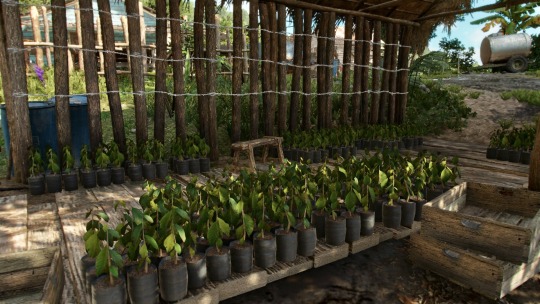
Homegrown coffee plantlets, Roxas Farm, Sierra Perdida, El Este.
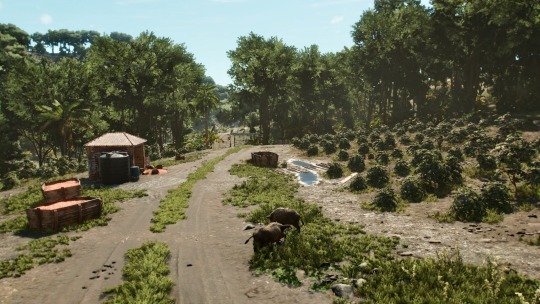
Wild boars grazing in the coffee fields, Roxas Farm, Sierra Perdida, El Este.
Growing coffee is certainly a labour of love.

A field worker spreading fertilizer by hand; Plantation in Robustas Hills, Sierra Perdida, El Este.
Back to Content Index
Harvesting and Processing the Beans
Small individual farms around the Sierra Perdida province grow, harvest, and locally process the raw beans. They are hand picked, cleaned, and dried in the Yaran sun. Afterwards, the coffee beans are sent to Santo Gusto Coffee Factory for further processing and packaging for distribution.

Freshly picked coffee beans, Bolivar Farm, Sierra Perdida, El Este.
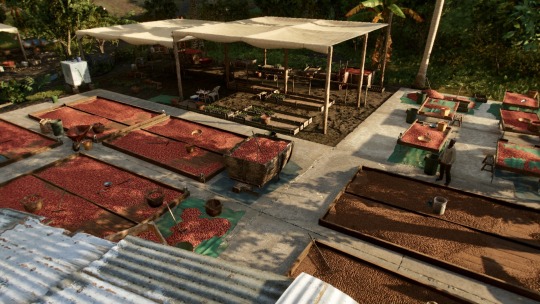
Sun drying coffee beans, Garbey Farm, Sierra Perdida, El Este.
Santo Gusto Coffee Factory
Every stage of coffee production is highly regulated by the government of Yara to ensure top quality of the final product, and for this, there is constant FND (Fuerzas Nacionales de Defensa) presence on location at the processing facility. Moreover, cameras, security systems and armed guards make approaching the facility problematic, let alone visiting it.
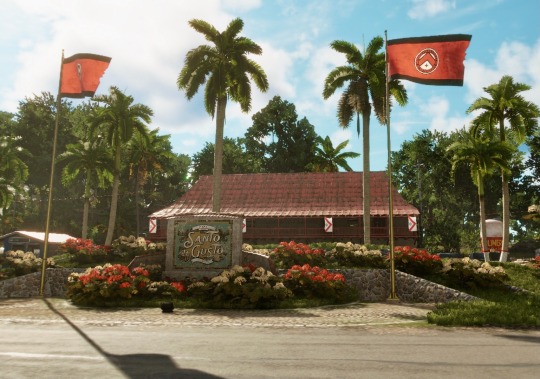
Outside Santo Gusto Coffee Factory.
However we were able to grant ourselves temporary access to the factory grounds - by means which will not be disclosed here - and got to play factory workers for a day for the sake of this article.


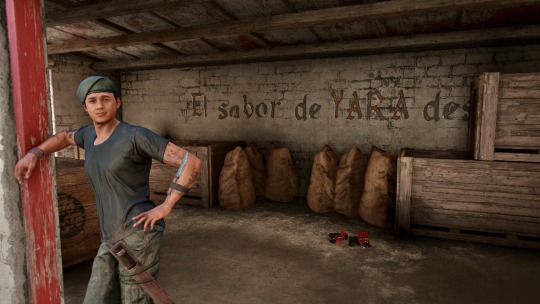
One of our crew members posing inside a storage room in Santo Gusto Coffee Factory.

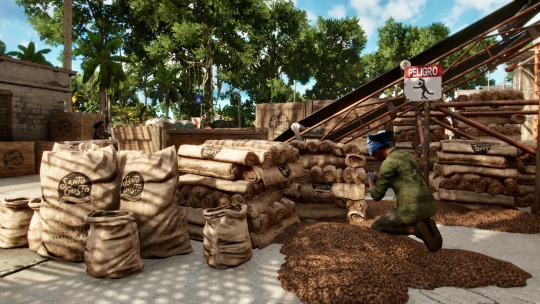
Main entrance to the processing facility, Santo Gusto Coffee Factory; Crew member modeling picking through dried coffee beans.
Jobs! Jobs! Jobs!
Coffee is an important industry for Yara’s economy and makes up for ehhh 37% of all jobs. It is responsible for creating employment for countless Yarans, from farmers, factory workers, to delivery truck drivers, and coffee shop owners.

A roadside barista offers freshly ground and brewed coffee, Sierra Perdida, El Este.
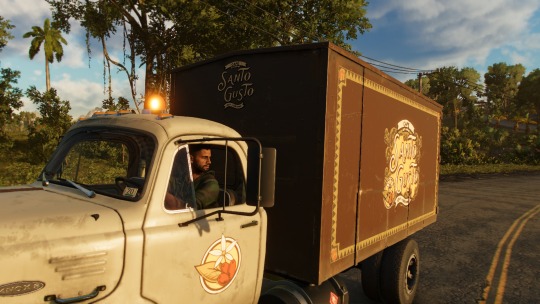
A photogenic delivery truck driver.

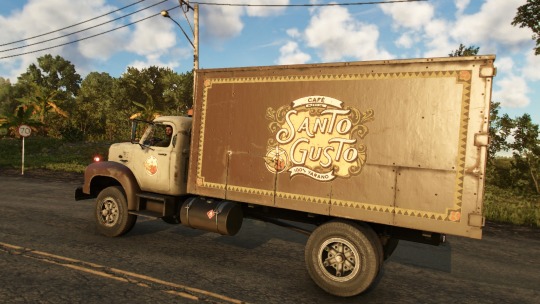
Sponsoring Street Racing?
Santo Gusto Café is itself overseen and partly funded by Yara’s government, but the company remains independent enough to sponsor community events. It is the main sponsor for a highly popular annual street race.


The race sets out from the small community of Santo Domingo.

Santo Domingo, Sierra Perdida, El Este.
The course twists and turns through the muddy trails of Robustas Hills and anyone with a pickup with decent enough suspension can take part.

A racer taking part in Santo Gusto sponsored street race.
Contestants don’t race against one another simultaneously, but rather against the clock for muddy glory. This is to keep the event relatively safe since the course does run through a main road as well.
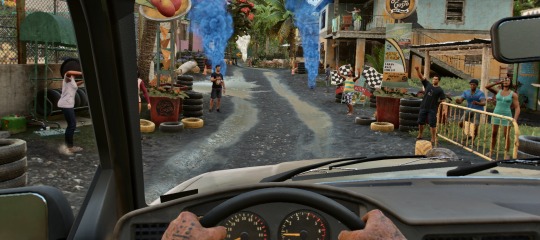

A driver taking part in Santo Gusto sponsored race to a fiery finish line.
If you enjoyed this article and would like to learn more about activities, places, events, and all things Yara, come back and visit this page often and follow us on Tumblr!
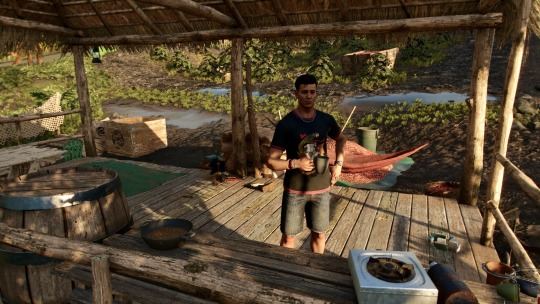
Stay tuned for an exclusive guided tour INSIDE the factory!
Editor's Notes:
Coffee growers being so strictly regulated by the Yaran government, some take it upon themselves to grow a little extra and sell it on the side. You gotta make a living wage somehow.

Also, don't be fooled: orgánico, shmorgánico. The wind doesn’t care about your feelings and PG-240 compound IS in your coffee. Lo siento.
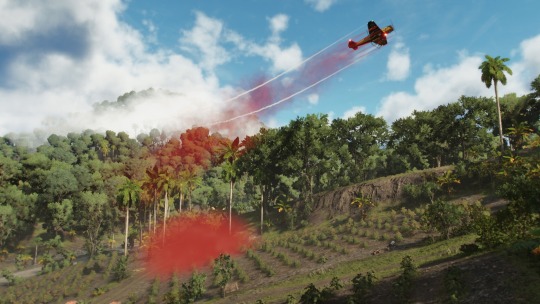
Back to Content Index
#visityaratoday#visit yara#far cry 6#far cry#virtual photography#far cry series#Virtual Tourism#visityara#virtual travel
3 notes
·
View notes
Text
MicroKillers
Runner-up in the University of Portsmouth Short Story Prize 2023
A weight lifted as the doctor took Lily from my arms and laid her on the medical table.
“Daddy, weren't you coming too?”
The tails of the body straps were hanging just out of sight beside her.
“No, baby, I have to wait here. But I’ll see you in fifthteen minutes.”
I pinched the fat on her cheeks and the doctor carted her toward the double doors.
Her mother had described the procedure to me before Lily was born. Back then, they provided a curtain and even a chaperone if the girls were particularly anxious about the discomfort.
Back then, the council could afford anaethesia too.
Drumming rumbled through my ears as I caught the last sight of my daughter between the doors, her gappy smile still intact. The silence that followed left the sinking realisation that she would not have gone quietly had I resisted.
A dull howling began to trickle through the doors.
⤧
At our next visit the following month, another doctor, whose jovial nature would not be contained by the triviality of a waistline, assisted Lily through the glass doors at the hospital entrance.
“Okay! Good news first.” Lily hovered by the office door. I pulled her over, my comfort rejected as she wrestled in my arms. “Lily’s infection is gone, which means she is now eligible to be put into the system and matched. Today — with your permission, sir.”
Lily pressed her fist into my chest. It had been her eleventh birthday yesterday and I’d promised we’d see the rides at the pier after her appointment.
“You want to match her today?”
“Oh, goodness!” The doctor laughed. “If only things were still so efficient. No, the process may take some months.”
Fabric tightened around my collar and I suppressed a choke. I captured Lily’s fist and rocked her, wondering how far we could make it beyond the channel, if we found a boat, before the wasteland consumed us or we starved…
“Unfortunately, the physical t-r-a-u-m-a from the removal for cryopreservation has left some questions regarding her fertility. However, we are confident that any faults will be corrected with a viable match, okay?”
Her mother would’ve known how to delay all of this.
“And her heart?”
“There aren’t any indications that your daughter has inherited your match’s—”
“Lucy.”
“...Lucy’s arrhythmia. Lily’s sangius-plasticus is lower than the current average for girls her age.”
⤧
Lily’s partner, Nicholas, fourteen, seemed too old to have lived so long unmatched.
“He has incredibly low sanguis-plasicus levels,” the doctor had said, “and his life expectancy is almost forty! Wonderful news for your gene pool, sir.”
Behind the thick rim of his glasses, Nicholas’s face swarmed with acne. He stood frigidly on the pier and stared at Lily.
I found the boy's father to be rather charming. He had dedicated his life to substituting epoxy resin—
“That used to line our food rations, didn’t it, Daddy?” Lily interjected.
“It did indeed,” Nicholas’s father replied. “My product not only combats microplastic infusion but contains isoflavones. Do you know what those are?”
“Isn’t that for old women?”
“Well, yes,” Nicholas piped up, “but Dad found a way to enhance their cancer fighting properties—”
“Even if the tumor is already growing?”
“Iso’s slow the growth, see…”
Nicholas’s father and I smiled at one another. It appeared the pair had their intelligence to bond over, Nicholas gaining a side to Lily I had yet to meet.
For his sake, I hoped it would be enough by the time he was due to fertilise.
⤧
“It hurts, Daddy, it hurts so bad—”
“Not long now, baby. It’ll all be worth it, I promise.”
I wiped sweat from her forehead, her face convulsing pink and agonised— a gasp clawed its way out of her.
“Update, nurse?”
“Still not at transition. Patient is not yet fully dilated, sir.”
Lily had been disabled by contractions for eighteen hours at this point. She grasped my hand and cried out for her mother.
The doctor motioned for the nurse, and they stepped beyond the opaque window. Exasperation etched through the glass, I jolted as the nurse threw her clipboard at the doctor. Lily howls, drawing my attention until the doctor reenters.
“I need to operate, if you would step outside.”
Behind him, the nurse's arm lays exposed and twitching on the marmoleum floor.
“I-I’m staying for the birth of my grandchild.”
Lily rocked beside me. I stepped between her and the doctor, feigning strength.
“You must step outside, sir.”
Security’s padded silhouette passed the window.
“No. I am staying with my child—”
Lily’s hand clamped around my arm as security yanked my shirt.
“Daddy, look after my baby—”
I saw the minutes trapped in her eyes.
“—Promise me, Daddy.”
She squeezed my hand and time became tame.
Eternity stretched between us.
I let her go.
— A. K. D
#creative writing#original fiction#writers on tumblr#female writers#women writers#writers block#writing inspiration#writerscommunity#short story#writersnetwork#dystopia#writing scifi#writing ideas#writing prompt#plastic#microplastics#family#relationship#heartbreak#writerslife#writers of tumblr#writblr#poets on tumblr#original poem#poetry#original poetry#death and dying#environment#climate crisis#climate change
3 notes
·
View notes
Text
1. For accurate quantification, distribution and management, avoid uneven distribution of nutrients.
2. Prevent dust from flying and adhering to the wall of the device. Dust flying, dust adhesion is serious. After granulation, environmental pollution and loss of raw materials can be prevented.
3. Prevent segregation of fertilizer components. When the particle size and density of each component in the formulation are different, segregation is prone to occur. Granulation can effectively prevent the segregation of fertilizer particles.
4. Prevent agglomeration in the production process of certain solids, such as the production of granular phosphamide, urea, etc. Generally, the particle size is larger than that of the powder, and the specific surface area of the material after granulation is greatly reduced.
5. Adjust bulk density, increase or prolong the storage time of fertilizer.
6. Easy to use, carry and transport, increase the value of commodities, etc.
Zhengzhou Huazhiqiang organic fertilizer equipment manufacturer is based on the principle of honest management, aggressive and pioneering, including organic fertilizer production line, npk production line, etc., perfect after-sales service and supporting facilities. It is a main organic fertilizer granulator (roller granulator, disc granulator machine, etc.), organic fertilizer turning and throwing machine, organic fertilizer pulverizer, organic fertilizer fermentation machine and other organic fertilizer equipment manufacturers for a complete set of organic fertilizer production lines. The technology development system has won unanimous praise from users.
2 notes
·
View notes
Text
While that data was... oddly thorough, it was normal, for the most part. It meant that they had definitely been keeping a close eye on absolutely everyone who lived above ground, yeah, but that wasn't shocking given who it was they were dealing with, and the data itself was pretty standard cataloguing affair...
... minus those last few lines.
"Conflict over diseased vegetables..." was what stuck out to Vash the most, because that string of information specifically would help the pieces inside his head slide more firmly into place. Tables of micro and macronutrients, environmental analysis detailing things like UV cycles, artificial versus the natural suns, fertilization, irrigation system blueprints--
"... so, this place was a farm." the blond concluded after a few moments of silence, throwing Wolfwood a look over his shoulder. "Actually, that's probably not the best word for it, but it looks like they were trying to produce fertile soil to be able to grow flora themselves-- the same thing Luida does in the observatory. And from the sounds of it, they wanted to use this place for food production..."
A decent enough conclusion to come to with what they had... but that just couldn't satisfy that one squeaking wheel-- because if that was the case, then why keep such detailed tabs on the people above all the way down here? Wouldn't that just clog up the experiment data? This sort of thing was all well and good for the furthering of humanity, but... that wasn't what the Eye of Michael had been focused on. What they'd wanted was the advancement of the human race itself; evolving past the need for food and sleep to be more like... them, a detail that Vash was loathe to think about, and skipped over it as quickly as he could.
Knowing all of that, one question remained: why the hell would the Eye of Michael bother with food production? Aside from maybe taking strain off of the Dependents as they worked-- or some other reasons he would really, really prefer not to think about at the moment --those two aspects just didn't align with each other at all...
... Vash frowned and banished everything from the screen, finally clicking open the final folder available to him. Enhancements. Inside were two more folders-- one labeled 'Plant-derived' and the other labeled 'Compost'. The first one was pretty self-explanatory: raw nutrients made by Plants that they mixed into the soil samples with-- from what he glimpsed as he took to speed-reading over this section --varying degrees of success.
Compost, though... had even more folders when he clicked it open, with labels that somehow managed to be straightforward and entirely vague, like calcium-enriched. Magnesium-enriched. Potassium-enriched.
Iron-enriched.
... may provide additional supplements and beneficial data...
"... Wolfwood, are there more people on file there?"
"Hm, so they were here even after JuLai..." Wolfwood trails off, moving the cursor back to the beginning of the folder where a document—one of those fancy, ready to print ones—stares back at him. He'd wanted to get an idea of what was in the rest of the folder before opening it. Bored of the simple everyday shots, Wolfwood skips towards the end, where it becomes... a little more interesting.
He's confused by what he's looking at in the last picture. The woman appears to be leaving town with all of her belongings. The crops are entirely wilted—honestly, they look sick. This isn't the scene he saw at the beginning of the folder.
Backtracking, Wolfwood flips through a gradual decline of aggression and depression until he reaches what seems to be a breakpoint.
It's a town hall meeting. A woman is crying—not whoever this poor sap was—and pleading with the mayor. The subject sits horrified in the corner of the room—genuinely horrified. Next are a few more shots of the subject working the fields, using the same tools and materials as always.
A camera in the corner of the medical office's waiting room spots Hyde meeting with a doctor of some kind amicably. She's in motion, walking back with him. His expression is grave. The next image, she's fuming, rushing out the door mid-yell. She's... worried about something. Now, the snapshots begin to get... weird. There are cameras in her house, watching her take care of her two children. One is a teenager, the other is maybe nine or ten. They seem happy together, but the mother is putting on a face to hide the truth from her kids.
The more the pictures go on, the darker the teenager's expression becomes. He turns, what appears to be, mistrusting... skeptical. At one point, the mother catches him snooping around the field at night and they appear to get into a huge spat. More and more of the townsfolk appear, guns are flashed. She backs off immediately, confused. She gestures to herself in frustration, shouting at the other townsfolk as though scolding them.
And then...
A dark corner of her house. She's crying. Praying. Wolfwood squints and can, of course, see Eye of Michael related materials. The symbol on a banner on the wall, the Eye's special bible, a painting of the 'angels'...
Another fight with her children. The younger one is confused—they look sick. They look like a light breeze will knock them over. Finally, it's the last picture. The subject walking in the distant horizon, away from the fields, fully draped in all of her things.
Then how did she end up here?
Wolfwood opens the introductory document and begins to read it aloud:
Subject: Clara N. Hyde ID: 2244CH Sex: F Age: 34 Status: Widowed Occupation: Manages the fields.
He mumbles through some basic details like height, weight, and vitals. Health conditions. Family. Why she moved there.
Then... it feels weird.
Diet: Red meat, hearty vegetables. Fruit rare. Indulges in sweets often. Particularly a fan of white chocolate chip cookies—a family recipe. Always cooks own meals, rarely hosts guests. Build: Muscular arms, abdomen, and back. Stays in shape due to nature of her work. A healthy padding of fat. No missing parts, no major scars, and no clear disabilities of note. Retrieval Method: Social Extraction due to conflict over diseased vegetables. Banished from town indefinitely. Notes: Feisty. Hard to keep in a cage, hard to tame. Partial to hunger strikes. Capable of unarmed combat. Active mind may provide additional supplements and beneficial data.
The undertaker adds a questioning inflection to the final sentence he reads. What the hell does that mean?
#curtains up ✧〗( ic )#unmade ✧〗( main verse )#he might get burned but he's in the game ✧〗mothwood ( forgivenpunishment )#( create! detailed! backstory! )#( not horrifying implications at all! )#( sorry to make you do more computer things ww but the pieces are falling into place and vash is Not Liking The Direction This is Heading-#forgivenpunishment thr 09
235 notes
·
View notes
Text
How can organic fertilizer production lines run more safely and reliably
To run the organic fertilizer production line more safely and reliably, the following measures can be taken:
1. Establish and improve the safety production management system: formulate relevant systems and norms, clarify the responsibilities and authority of each post, and ensure the reasonable staffing and training of personnel.
2. Equipment maintenance and maintenance: regular inspection and maintenance of organic fertilizer equipment, timely detection and troubleshooting. The old equipment should be replaced or updated in time to ensure the safety and reliability of the equipment.
3. Product quality monitoring and inspection: Strengthen the quality monitoring and inspection of organic fertilizer products to ensure that product quality meets standards, which is directly related to the growth of crops and farmers' income.
4. Safe and stable operation measures in winter: In winter, the organic fertilizer production line should be regularly checked, including the operating status of the equipment, lubrication, fastening, etc., to ensure that the equipment is in good working condition. At the same time, add antifreeze, check the tightness of the triangle belt of the drive motor, maintain appropriate humidity and temperature, preheat the equipment and arrange the production task reasonably.
5. Comply with national technical standards: according to the technical requirements of the design, construction, acceptance and operation and maintenance of organic fertilizer projects, to ensure safety and application, energy saving and environmental protection, economic and reasonable, advanced technology and reliable performance.
(6) Labor safety and industrial hygiene: the construction, operation and maintenance of the project shall take effective measures to ensure personal and public safety, including labor safety and industrial hygiene.
Through the above measures, the safety and reliability of the organic fertilizer production line can be effectively improved to ensure the smooth progress of production.

0 notes